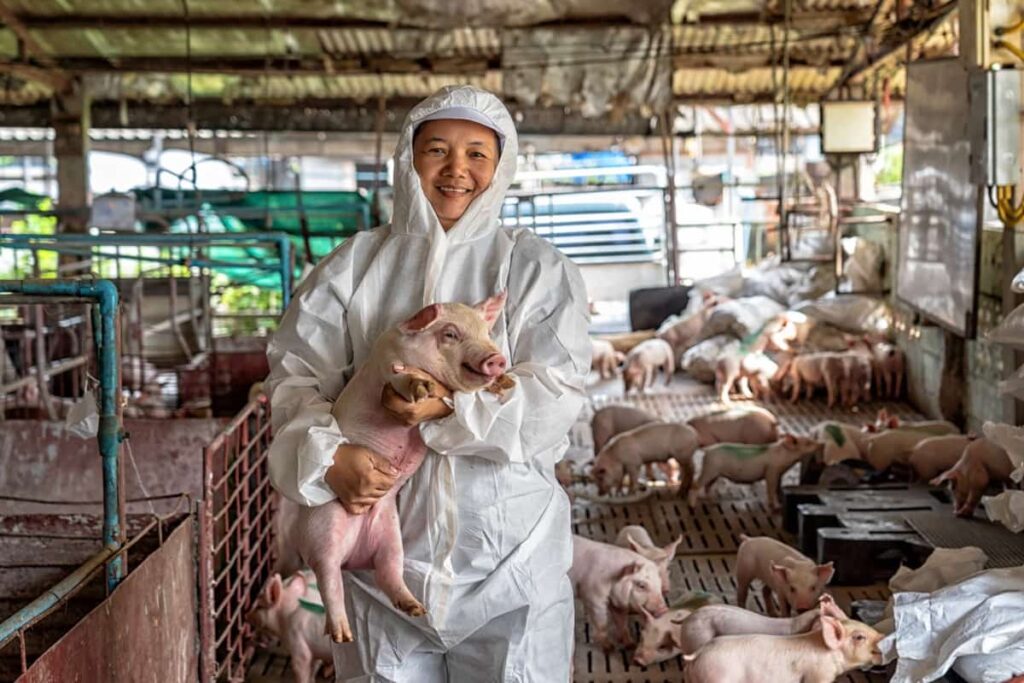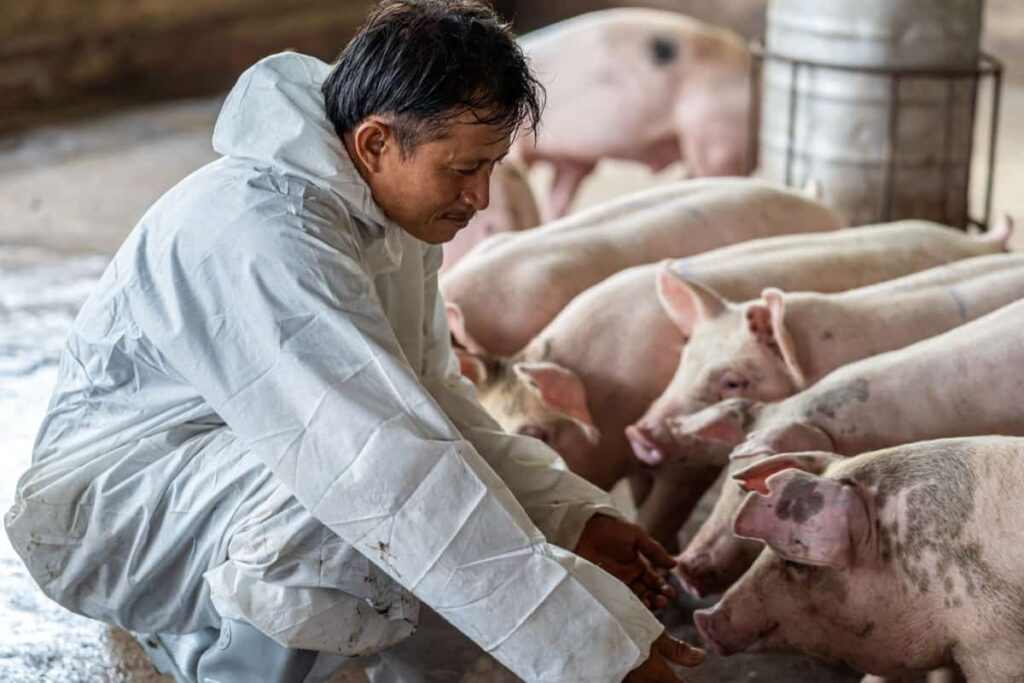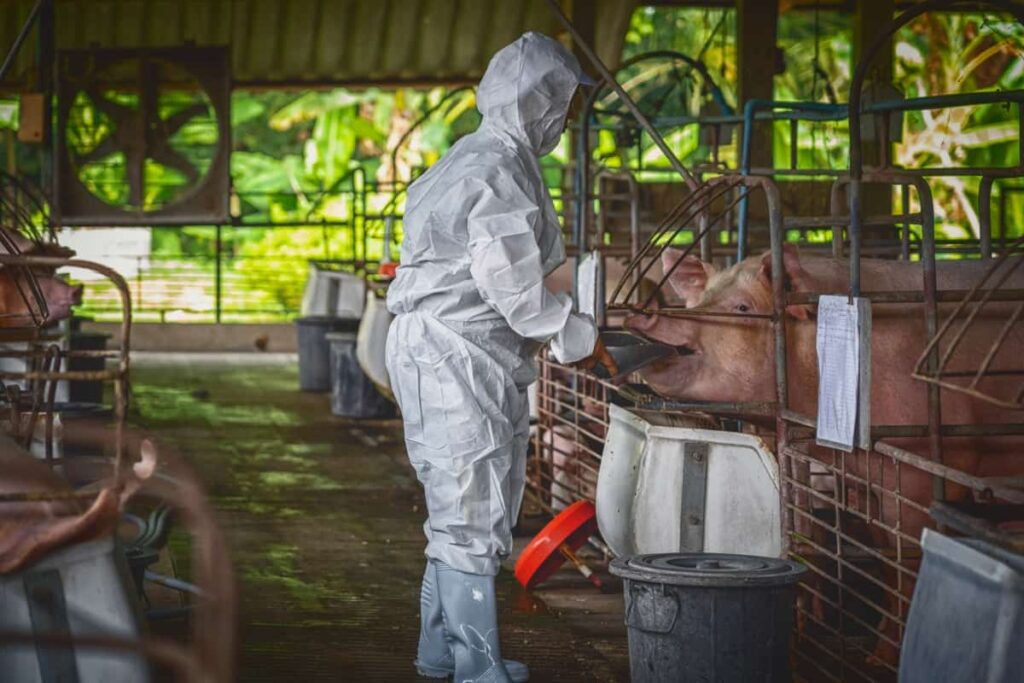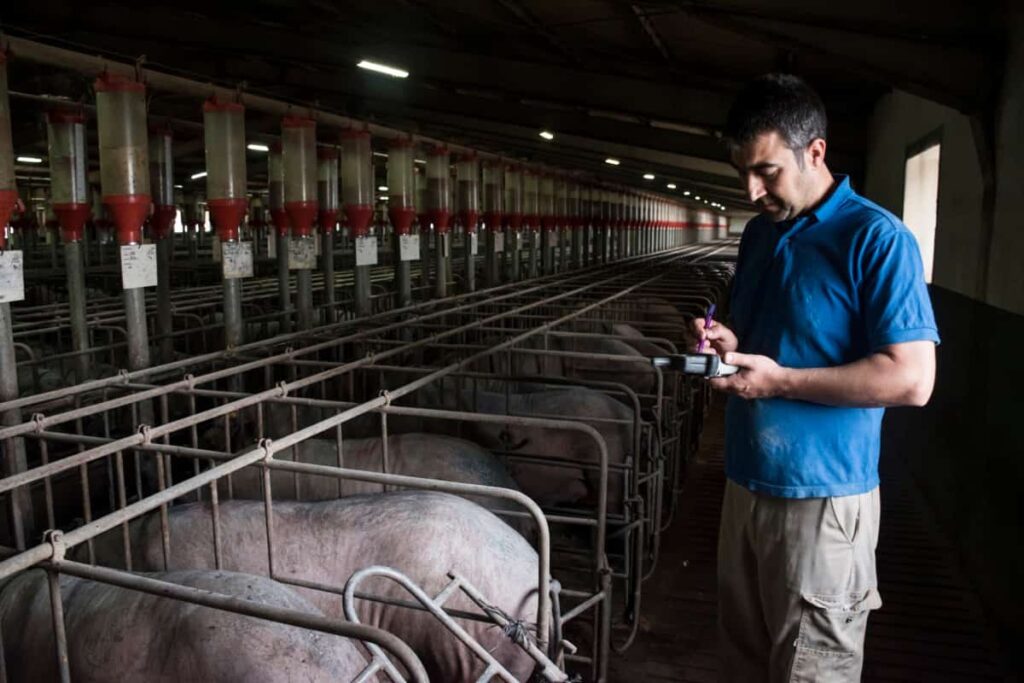Welcome to our blog on Pig Farm Operations Management! You’re in the right place if you’re a pig farmer or interested in the swine industry. In this, we will explore the importance of month-wise maintenance for maximizing profits in pig farming. By following a well-planned maintenance schedule, you can ensure the health and productivity of your pigs throughout the year.

We will provide accurate data, expert insights, and practical tips, along with month-wise pig farm maintenance details to help you streamline your operations. Whether you’re a seasoned farmer or just starting, this blog aims to provide valuable information and engage you. Get ready to optimize your pig farm and boost your profits!
What is Pig Farm Operations Management?
Pig Farm Operations Management refers to the strategic planning, organization, and execution of various activities in a pig farm. It encompasses pig selection and breeding, nutrition management, health monitoring, waste management, and overall farm maintenance. Effective management is crucial for ensuring the pigs’ health, welfare, and productivity while optimizing profitability for the farmer.
Pig Farm Operations Management refers to the strategic planning, organization, and execution of various activities in a pig farm. It encompasses pig selection and breeding, nutrition management, health monitoring, waste management, and overall farm maintenance. Effective management is crucial for ensuring the pigs’ health, welfare, and productivity while optimizing profitability for the farmer.
Best Pig Farm Operations Management and Maintenance Tips
Breeding Care: Plan two farrowing per year under optimal management conditions to maximize fertility. Maintain one boar for every ten sows to ensure maximum fertility. Breed sows during their peak heat period, typically within 12 to 24 hours of heat.
Care During Pregnancy: Give special attention to pregnant sows one week before farrowing by providing adequate space, feed, and water. Disinfect the farrowing pens and place the sows in them after proper bedding. Take precautions to ensure the health and comfort of the pregnant sows.
Care of Piglets: Provide guard rails for newborn piglets and disinfect their navel cords with a tincture of iodine. Feed them with their mother’s milk and creep feed for the first 6-8 weeks. Protect the piglets from extreme weather conditions, especially during the first two months. Clip their needle teeth shortly after birth and vaccinate them according to the recommended schedule. Supplementation of iron is necessary to prevent piglet anemia.
Care and Management of Sows: Sows should be well-cared for, primarily for breeding. Proper management and feeding minimize breeding-related issues. Ensure that sows deliver piglets normally and nurse them properly.
In case you missed it: Pig Farming Project Report: Investment, Profit for 10, 20, 50, 100, and 500 Pigs/Hogs

Farrowing Sow and Litter: Clean and disinfect the farrowing pens before use. Deworm the pregnant female a few weeks before farrowing. Provide light bedding a few days before farrowing. Attend the farrowing process and clean and disinfect the piglets. Provide necessary care and remove waste promptly. Ensure the piglets start suckling within 10-15 minutes after birth.
Breeding Management: Induce heat (estrus) through good feeding and management practices to make breeding easier and achieve larger litter sizes. To promote weight gain, include grains, fish meal, skim milk, or buttermilk in the diet before breeding.
Care and Management of Boar: Maintain boars in separate pens and provide proper feeding to ensure their breeding capacity. Keep the pen clean and dry, and regularly trim the boar’s feet to prevent lameness. Introduce newly purchased boars to the farm after a quarantine period.
Care and Management of Piglets: Clean the piglets and ensure their breathing passage is clear. Tie the navel cord, remove the remaining portion hygienically, and paint the stumps with iodine. Nurse the piglets after birth and clip their teeth to prevent injuries to the sow. Take measures to prevent piglet anemia by providing appropriate minerals.
Nutrition: Swine have varying nutritional requirements based on sex, age, and physiological status. Different groups of swine, from young pigs to lactating sows, require specific diets to meet their nutritional needs.
Manure Disposal: Collect and store the dry solid dung in a dung shed. Divert the liquid part of urine and washings to settling tanks for proper disposal.
Integration: Pig farming can be integrated with other agricultural activities, such as biogas plants, agriculture, and fish culture, to enhance economic efficiency. Pig dung can serve as organic manure or compost.
Feeding Management in Pig Farm Operations
Feeding management is an important part of pig farm operations, as it significantly impacts pigs’ growth and mortality rates. Approximately 70-75% of the total production cost is attributed to feed expenses. Farmers aim to rear pigs efficiently by providing economical yet balanced feed containing all necessary nutrients for growth and overall well-being.
Two feeding methods are commonly practiced in pig farms concentrated feed computed with different ingredients and concentrated feed mixed with locally available agro-industrial by-products, tuber crops, vegetables, kitchen waste, etc.
Feed Formula for Different Categories of Pigs: To ensure optimal growth, pigs of different categories require specific feed formulas. The protein and ingredient requirements for weaner (18-20% protein), growers (15-17% protein), and gilt/sow/boar (14-16% protein) pigs: Maize, Ground Nut Cake, Wheat Bran, Rice Polish, Fish Meal/Soya Meal, Mineral Mixture, Salt.
Feeding of Pregnant Animals: During pregnancy, pregnant animals have increased demands for proteins, vitamins, and minerals. Sows and gilts should be fed adequately to avoid being overfat or thin. Feed them lightly before and after farrowing, gradually increasing to full feeding within ten days. Greens can be provided, and the feed allowance should be calculated based on body weight and piglet count.
In case you missed it: How to Make Silage for Livestock: Business Plan, Preparation Process for Goats, Sheep, Pigs, and Cows

Creep Feeding: Creep feeding involves providing concentrated feed separately to young piglets in an enclosure away from their mother. This practice starts when piglets are two weeks old. Piglets can consume approximately 10 kg of feed before reaching eight weeks of age, with two-thirds consumed between six and eight weeks.
Orphan Pigs: In cases where a sow cannot nurse or care for her piglets, they should be promptly shifted to a foster mother. If a lactating mother is unavailable, substitutes such as cow’s milk, buttermilk, or sweet skim milk can be used. Each piglet may consume 300-500 ml of milk daily, gradually reducing feeding frequency. Adequate warmth should be provided using a 60-Watt electric bulb during the early days of life.
Flushing: Flushing refers to increased feeding of sows and gilts before breeding to enhance litter size. A good grower ration is fed to pigs seven to ten days before breeding to increase the ovulation rate. After breeding, animals should be fed a limited but well-balanced ration until the last six weeks of pregnancy, after which full feeding should be resumed.
Housing Operations Management in Pig Farm
Choosing the right site for a pig farm is essential, preferably near a town or city, to minimize transportation costs and facilitate marketing. Housing is necessary to protect pigs from environmental factors. Pigsties can be constructed using locally available wood, bamboo, thatch grass, or more permanent materials like brick walls and corrugated galvanized iron/asbestos sheet roofing.
Floors should be cemented for easy cleaning, and sufficient space must be provided based on the number of pigs housed. Ideally, each pig should have a minimum of 2-2.5 square meters of space. Proper ventilation, lighting, and drainage systems should be in place. Feeding troughs and waterers should be easily accessible, and regular cleaning and disinfection should be practiced. Providing clean and fresh water at all times through automatic waterers or nipple drinkers.
Month-wise Pig Farm Maintenance For Better Profits
Month-wise maintenance operations in pig farming play a role in maximizing profits. Each month presents specific challenges and opportunities, from ensuring optimal temperature and ventilation in January to managing heat stress in July and focusing on feed efficiency in August. By implementing proper maintenance strategies, pig farmers can enhance pig health, growth, and overall profitability throughout the year.
January Month Maintenance Operations of Pig Farm
In January, focus on maintaining optimal temperature and ventilation in the pig housing. Cold weather can stress the pigs, reducing feed intake and growth. Ensure proper insulation, check heating systems, and monitor humidity levels. Implement biosecurity measures to prevent disease introduction. Provide clean and warm bedding for the pigs. Adjust feed rations to meet their energy requirements and support growth during winter months. Monitor the water supply to prevent freezing. Regularly assess the body condition of the pigs to ensure they are maintaining optimal health.
February Month Maintenance Operations of Pig Farm
In February, pay attention to reproductive management. Observe heat cycles and implement artificial insemination techniques for controlled breeding. Monitor gestating sows for body condition and adjust feed accordingly. Provide proper nutrition to support embryo development and maximize litter size.
Regularly check for signs of illness, especially respiratory diseases. Implement vaccination programs to prevent common diseases. Keep the pig housing clean and dry to minimize the risk of infections. Assess the growth and development of piglets and provide supplemental heating if needed.
In case you missed it: How to Start Sustainable Pig Farming: Business Plan, Benefits, and Requirements

March Month Maintenance Operations of Pig Farm
March is the month for piglet management. Focus on providing a warm and comfortable environment for newborn piglets. Monitor their health and ensure they receive colostrum within the first 24 hours of life. Implement proper creep feeding techniques to encourage early intake of solid feed. Vaccinate piglets according to the recommended schedule. Monitor their growth and adjust feed rations accordingly. Assess the condition of the sow and provide any necessary treatments. Regularly clean and disinfect the pig housing to prevent the spread of diseases.
April Month Maintenance Operations of Pig Farm
In April, emphasize pasture management for outdoor pig farming systems. Prepare pastures by removing weeds and ensuring adequate grass growth. Rotate pigs to different grazing areas to prevent overgrazing and maintain pasture quality. Monitor the pigs for signs of parasites and implement appropriate deworming protocols. Adjust feed rations to account for increased access to forage. Provide shelter and shade for the pigs during hot weather. Regularly inspect fences and repair any damages to ensure the safety and containment of the pigs.
May Month Maintenance Operations of Pig Farm
May is an ideal time to focus on nutritional management. Monitor the growth and body condition of the pigs and adjust feed rations accordingly. Provide a balanced diet that meets the specific nutrient requirements of each growth stage. Evaluate the quality of feed ingredients and ensure proper storage to prevent spoilage. Consider supplementing with vitamins or minerals if deficiencies are identified. Monitor water quality and availability to promote proper hydration. Regularly assess the health of the pigs and address any nutritional or digestive issues promptly.
June Month Maintenance Operations of Pig Farm
In June, prioritize herd health management. Conduct regular health assessments and consult a veterinarian for preventive treatments and vaccinations. Monitor pigs for signs of respiratory diseases, parasites, and other common ailments. Implement biosecurity measures to prevent disease introduction, such as controlling visitor access and sanitizing equipment. Assess the body condition of the pigs and adjust feeding strategies accordingly. Ensure proper sanitation and waste management practices to minimize disease transmission. Provide a comfortable and stress-free environment for the pigs to promote overall well-being.
July Month Maintenance Operations of Pig Farm
July is a month to focus on heat stress management. Monitor the pigs for signs of heat stress, such as panting and decreased feed intake. Provide adequate shade and ventilation to minimize heat-related issues. Consider using sprinklers or misters to cool the pigs and their environment. Adjust feed rations to account for reduced appetite during hot weather. Ensure a clean and abundant water supply to prevent dehydration. Monitor the pigs for signs of illness or infection and take appropriate measures to address them promptly.
August Month Maintenance Operations of Pig Farm
In August, emphasizing the management of growing and finishing pigs. Monitor their growth rates and adjust feed rations to ensure optimal weight gain. Implement feed efficiency strategies to maximize profitability. Assess the body condition of the pigs and make necessary adjustments to feeding and health management practices. Monitor the pigs for signs of stress or disease and provide appropriate treatments or interventions. Conduct regular checks on the pig housing to maintain cleanliness and prevent the accumulation of waste.
In case you missed it: How to Grow Pigeon Pea/Red Gram/Toor Dal: Cultivation Practices and Production Management

September Month Maintenance Operations of Pig Farm
September is a critical time for preparing for the upcoming breeding season. Evaluate the condition and performance of the breeding herd. Implement pre-breeding vaccinations and reproductive management protocols. Assess the housing facilities and ensure they are suitable for breeding activities.
Adjust feed rations to support reproductive performance. Monitor the health of the pigs and address any issues promptly. Conduct routine fertility checks on boars and sows to ensure optimal breeding potential. Maintain a calm and stress-free environment to promote successful mating.
October Month Maintenance Operations of Pig Farm
In October, focus on optimizing feed efficiency. Monitor the growth of pigs and adjust feed rations accordingly. Conduct regular feed quality assessments to ensure optimal nutritional value. Consider implementing feed additives or supplements to enhance digestion and nutrient utilization. Evaluate the efficiency of feeding systems and make any necessary improvements. Assess the body condition of the pigs and adjust feeding strategies to maintain optimal health. Regularly clean and sanitize feeders and waterers to prevent contamination.
November Month Maintenance Operations of Pig Farm
November is a month to concentrate on biosecurity measures. Implement strict protocols to prevent the introduction and spread of diseases. Control visitor access and enforce proper sanitation practices. Regularly monitor pigs for signs of illness and promptly isolate and treat affected individuals.
Maintain a clean and hygienic environment by regularly cleaning and disinfecting the pig housing. Monitor the pigs’ overall health and provide any necessary vaccinations or preventive treatments. Review and update biosecurity protocols based on industry best practices.
December Month Maintenance Operations of Pig Farm
In December, prioritize winter management. Monitor the temperature and ventilation in the pig housing to prevent cold stress. Provide adequate bedding and shelter to keep the pigs warm. Adjust feed rations to meet their increased energy requirements during colder months. Monitor water supply to prevent freezing. Regularly assess the body condition of the pigs and address any health issues promptly. Implement biosecurity measures to prevent disease transmission. Review and update farm records and financial reports to evaluate the year’s profitability and plan for the upcoming year.
Note: The information is based on practices in pig farm operations. However, it’s important to note that specific management practices may vary depending on the location, climate, farm size, and production system.
In case you missed it: Sheep Farm Operations Management: Month-Wise Maintenance For Better Profits

Conclusion
Implementing month-wise maintenance practices in pig farm operations management is crucial for maximizing profits. By focusing on feeding management, housing, health monitoring, and record-keeping, farmers can optimize growth, reduce costs, and improve overall profitability.
- How to Raise Pigs in Your Own Backyard: A Comprehensive Guide
- Budget Friendly Sheep Shed Ideas: Cheap and Low-Cost Tips
- How Much Do Cattle Farmers Make: Revenue Streams in Cattle Farming
- Management Pests and Diseases in Your Cotton Field
- Sheep Farming Business Plan for Beginners
- Aquaponic Farming at Home: A Step-By-Step Guide
- Profitable Village Farming Business Ideas in 2024
- High-Yield Aquaculture: Fast-Growing Fish for Farming
- Effective Fish Pond Construction Techniques for Beginners
- Irrigation and Water Management in Pineapple Farming
- Blossom to Harvest: Mastering Flowering and Pollination in Papaya Farming
- Pig Fattening Essentials: From Selection to Sale for Beginners
- Raising Wagyu Cattle: A Complete Guide for Premium Beef Production
- Soil Types and Their Water Holding Capacity
- Optimizing Irrigation Schedules for Coconut Groves for Enhanced Yield
- Espresso Your Garden: Coffee Grounds for Healthier Acid-Loving Plants
- The Best Soil Mix for Snake Plants: How to Mix Your Own Snake Plant Soil
- Green Thumb Success: Expert Tips for Cultivating Greenhouse Beans All Year Round
- Bloom All Year Round: The Ultimate Guide to Indoor Hyacinth Care
- Eco-Friendly Gardening: How to Make Liquid Fertilizer from Kitchen Waste
- Ultimate Guide to Grow Anise in Pots: Explore Seed Propagation to Harvesting
- Guide to Raising Chester White Pigs: Discover Breed Facts to Growth Management
- Mastering the Elegance: The Ultimate Guide to Weeping Cherry Tree Care, Planting, and Maintenance
- Ultimate Guide to Planting Garlic in Grow Bags: Growing Strategies for Beginners
- How to Fix Spider Plant Leaf-Related Problems: Natural and Organic Remedies
- 10 Reasons Why Your Tulsi Plant is Shedding Leaves: Home Remedies and Solutions
- Optimizing Growth and Yield: The Advantages of Palm Bunch Ash Fertilizer
- Utilizing Neem Oil Extract as a Natural Pesticide for Hydrangea
- From Soil to Harvest: Various Ways in Which Farmers Can Use AI Tools
- Steps to Encourage and Induce Citrus Flowers: A Comprehensive Guide
- How to Fix Snake Plant Leaf-Related Issues: Natural and Organic Remedies
- Transform Your Garden into a Fragrant Oasis with Raat Ki Rani (Night Blooming Jasmine)
- Discover the Ideal Chicken Breeds for Philippine Farms
- How to Create a Poultry Egg Farm Business Plan for Profits
- Grow Lemon Cucumbers Like a Pro: Insider Techniques for Bountiful Yields
- Ultimate Guide to Caring for Your Pink Princess Philodendron: Tips for Thriving Variegation
